Yan Chang
COMPASS: Cross-embodiment Mobility Policy via Residual RL and Skill Synthesis
Feb 22, 2025



Abstract:As robots are increasingly deployed in diverse application domains, generalizable cross-embodiment mobility policies are increasingly essential. While classical mobility stacks have proven effective on specific robot platforms, they pose significant challenges when scaling to new embodiments. Learning-based methods, such as imitation learning (IL) and reinforcement learning (RL), offer alternative solutions but suffer from covariate shift, sparse sampling in large environments, and embodiment-specific constraints. This paper introduces COMPASS, a novel workflow for developing cross-embodiment mobility policies by integrating IL, residual RL, and policy distillation. We begin with IL on a mobile robot, leveraging easily accessible teacher policies to train a foundational model that combines a world model with a mobility policy. Building on this base, we employ residual RL to fine-tune embodiment-specific policies, exploiting pre-trained representations to improve sampling efficiency in handling various physical constraints and sensor modalities. Finally, policy distillation merges these embodiment-specialist policies into a single robust cross-embodiment policy. We empirically demonstrate that COMPASS scales effectively across diverse robot platforms while maintaining adaptability to various environment configurations, achieving a generalist policy with a success rate approximately 5X higher than the pre-trained IL policy. The resulting framework offers an efficient, scalable solution for cross-embodiment mobility, enabling robots with different designs to navigate safely and efficiently in complex scenarios.
A Pioneering Neural Network Method for Efficient and Robust Fuel Sloshing Simulation in Aircraft
Dec 14, 2024



Abstract:Simulating fuel sloshing within aircraft tanks during flight is crucial for aircraft safety research. Traditional methods based on Navier-Stokes equations are computationally expensive. In this paper, we treat fluid motion as point cloud transformation and propose the first neural network method specifically designed for simulating fuel sloshing in aircraft. This model is also the deep learning model that is the first to be capable of stably modeling fluid particle dynamics in such complex scenarios. Our triangle feature fusion design achieves an optimal balance among fluid dynamics modeling, momentum conservation constraints, and global stability control. Additionally, we constructed the Fueltank dataset, the first dataset for aircraft fuel surface sloshing. It comprises 320,000 frames across four typical tank types and covers a wide range of flight maneuvers, including multi-directional rotations. We conducted comprehensive experiments on both our dataset and the take-off scenario of the aircraft. Compared to existing neural network-based fluid simulation algorithms, we significantly enhanced accuracy while maintaining high computational speed. Compared to traditional SPH methods, our speed improved approximately 10 times. Furthermore, compared to traditional fluid simulation software such as Flow3D, our computation speed increased by more than 300 times.
X-MOBILITY: End-To-End Generalizable Navigation via World Modeling
Oct 23, 2024



Abstract:General-purpose navigation in challenging environments remains a significant problem in robotics, with current state-of-the-art approaches facing myriad limitations. Classical approaches struggle with cluttered settings and require extensive tuning, while learning-based methods face difficulties generalizing to out-of-distribution environments. This paper introduces X-Mobility, an end-to-end generalizable navigation model that overcomes existing challenges by leveraging three key ideas. First, X-Mobility employs an auto-regressive world modeling architecture with a latent state space to capture world dynamics. Second, a diverse set of multi-head decoders enables the model to learn a rich state representation that correlates strongly with effective navigation skills. Third, by decoupling world modeling from action policy, our architecture can train effectively on a variety of data sources, both with and without expert policies: off-policy data allows the model to learn world dynamics, while on-policy data with supervisory control enables optimal action policy learning. Through extensive experiments, we demonstrate that X-Mobility not only generalizes effectively but also surpasses current state-of-the-art navigation approaches. Additionally, X-Mobility also achieves zero-shot Sim2Real transferability and shows strong potential for cross-embodiment generalization.
DualFluidNet: an Attention-based Dual-pipeline Network for Accurate and Generalizable Fluid-solid Coupled Simulation
Dec 28, 2023
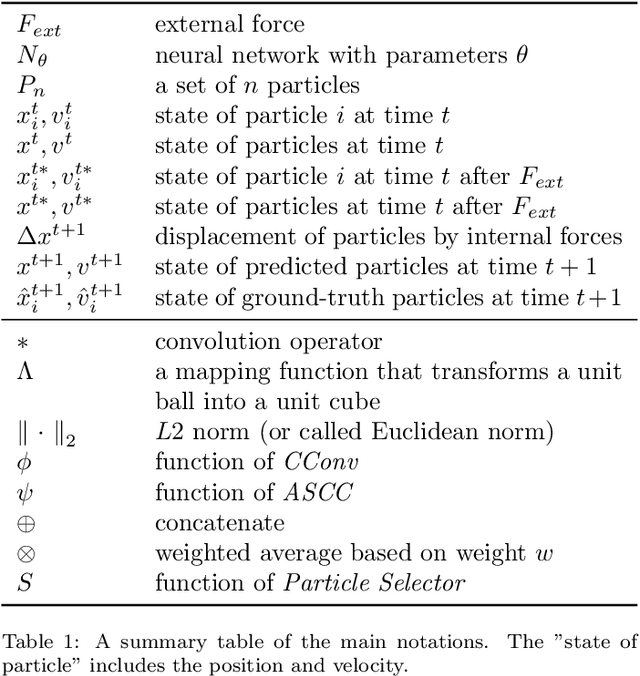


Abstract:Fluid motion can be considered as point cloud transformation when adopted by a Lagrangian description. Compared to traditional numerical analysis methods, using machine learning techniques to learn physics simulations can achieve near accuracy, while significantly increasing efficiency. In this paper, we propose an innovative approach for 3D fluid simulations utilizing an Attention-based Dual-pipeline Network, which employs a dual-pipeline architecture, seamlessly integrated with an Attention-based Feature Fusion Module. Unlike previous single-pipeline approaches, we find that a well-designed dual-pipeline approach achieves a better balance between global fluid control and physical law constraints. Furthermore, we design a Type-aware Input Module to adaptively recognize particles of different types and perform feature fusion afterward, such that fluid-solid coupling issues can be better dealt with. The experiments show that our approach significantly increases the accuracy of fluid simulation predictions and enhances generalizability to previously unseen scenarios. We demonstrate its superior performance over the state-of-the-art approaches across various metrics.
SafetyNet: Safe planning for real-world self-driving vehicles using machine-learned policies
Sep 28, 2021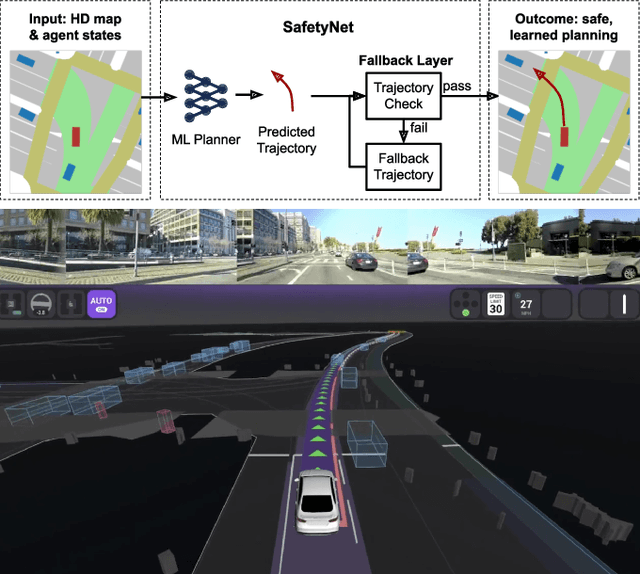
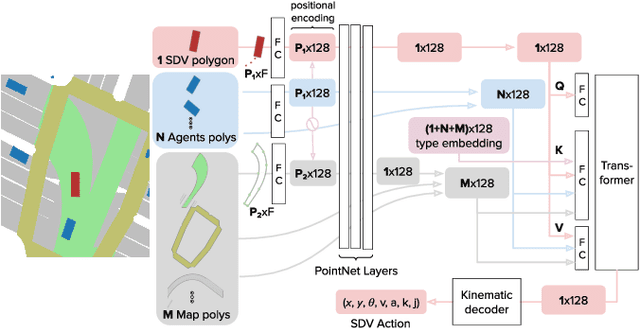
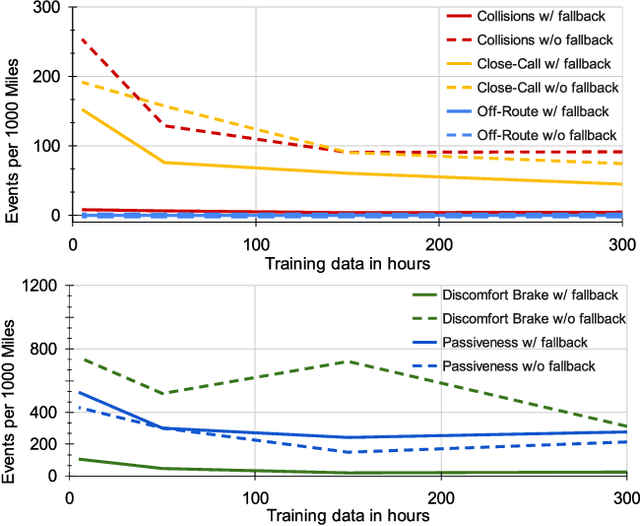
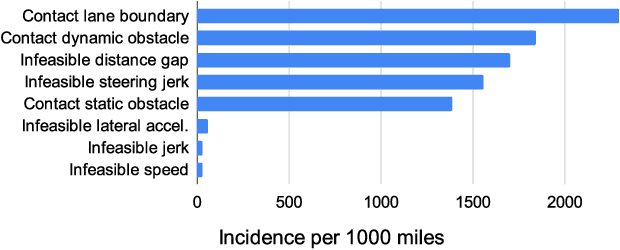
Abstract:In this paper we present the first safe system for full control of self-driving vehicles trained from human demonstrations and deployed in challenging, real-world, urban environments. Current industry-standard solutions use rule-based systems for planning. Although they perform reasonably well in common scenarios, the engineering complexity renders this approach incompatible with human-level performance. On the other hand, the performance of machine-learned (ML) planning solutions can be improved by simply adding more exemplar data. However, ML methods cannot offer safety guarantees and sometimes behave unpredictably. To combat this, our approach uses a simple yet effective rule-based fallback layer that performs sanity checks on an ML planner's decisions (e.g. avoiding collision, assuring physical feasibility). This allows us to leverage ML to handle complex situations while still assuring the safety, reducing ML planner-only collisions by 95%. We train our ML planner on 300 hours of expert driving demonstrations using imitation learning and deploy it along with the fallback layer in downtown San Francisco, where it takes complete control of a real vehicle and navigates a wide variety of challenging urban driving scenarios.
An Optimal LiDAR Configuration Approach for Self-Driving Cars
May 20, 2018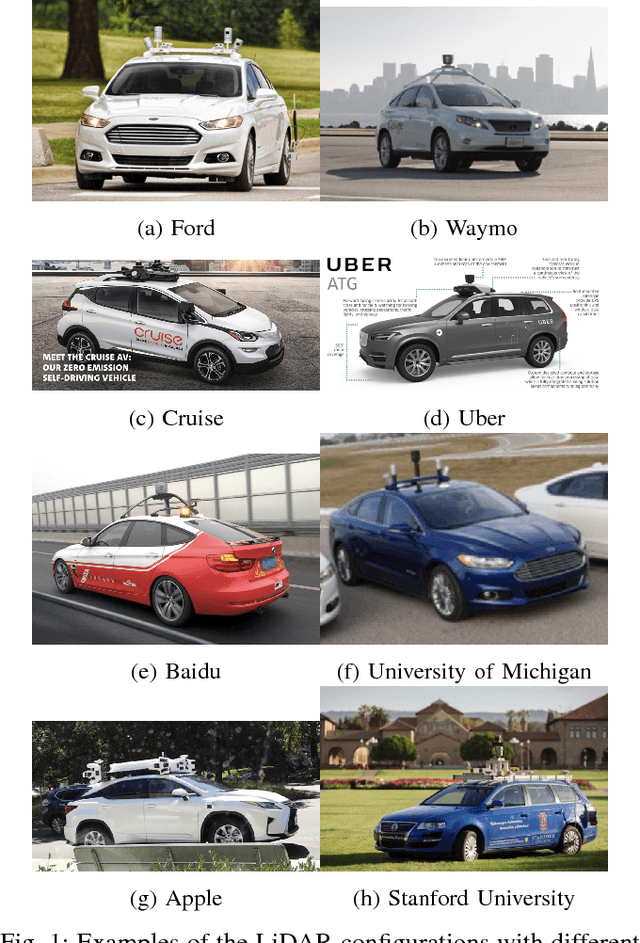



Abstract:LiDARs plays an important role in self-driving cars and its configuration such as the location placement for each LiDAR can influence object detection performance. This paper aims to investigate an optimal configuration that maximizes the utility of on-hand LiDARs. First, a perception model of LiDAR is built based on its physical attributes. Then a generalized optimization model is developed to find the optimal configuration, including the pitch angle, roll angle, and position of LiDARs. In order to fix the optimization issue with off-the-shelf solvers, we proposed a lattice-based approach by segmenting the LiDAR's range of interest into finite subspaces, thus turning the optimal configuration into a nonlinear optimization problem. A cylinder-based method is also proposed to approximate the objective function, thereby making the nonlinear optimization problem solvable. A series of simulations are conducted to validate our proposed method. This proposed approach to optimal LiDAR configuration can provide a guideline to researchers to maximize the utility of LiDARs.
 Add to Chrome
Add to Chrome Add to Firefox
Add to Firefox Add to Edge
Add to Edge